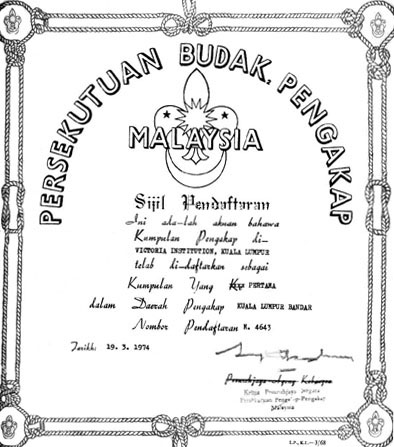
 o longer were the V.I. Scout Groups known as First or Second Selangor
nor even First and Second Kuala Lumpur. Now, with the creation of a
Federal Territory of Kuala Lumpur on 1 February 1974, those much-recognised
official names gave way to First and Second Kuala Lumpur Bandar, though
out of convenience, the Groups still continued to be known as First and
Second KL. But that name change was not the last. In the late 1970’s,
Second KL made an application to the Persekutuan Pengakap Malaysia
(Federation of Scouting, Malaysia) for the Group to be called Victoria
Scout Group (VSG). This application was granted in 1979, and has remained
as the name of the Group ever since. In contrast, First KL is known by
the name Seladang Scout Group (SSG) - a moniker whose first use has been
traced to The Victorian of 1983. Indeed, this was an epoch of
change, not merely of names. The new territory of Kuala Lumpur was no
longer part of Selangor. The Persekutuan was revising its badge tests
syllabi. The vernacular of instruction and communication in School was
changed from English to Malay, which also meant that new Scouting
publications in Malaysia were no longer in English. How did the V.I.
Scouts fare in the face of all these changes and more?
o longer were the V.I. Scout Groups known as First or Second Selangor
nor even First and Second Kuala Lumpur. Now, with the creation of a
Federal Territory of Kuala Lumpur on 1 February 1974, those much-recognised
official names gave way to First and Second Kuala Lumpur Bandar, though
out of convenience, the Groups still continued to be known as First and
Second KL. But that name change was not the last. In the late 1970’s,
Second KL made an application to the Persekutuan Pengakap Malaysia
(Federation of Scouting, Malaysia) for the Group to be called Victoria
Scout Group (VSG). This application was granted in 1979, and has remained
as the name of the Group ever since. In contrast, First KL is known by
the name Seladang Scout Group (SSG) - a moniker whose first use has been
traced to The Victorian of 1983. Indeed, this was an epoch of
change, not merely of names. The new territory of Kuala Lumpur was no
longer part of Selangor. The Persekutuan was revising its badge tests
syllabi. The vernacular of instruction and communication in School was
changed from English to Malay, which also meant that new Scouting
publications in Malaysia were no longer in English. How did the V.I.
Scouts fare in the face of all these changes and more?
BADGEWORK PURSUIT AND ACCOLADES
The last time before this epoch that the V.I. produced
Pengakap Raja was in 1971, in the person of Yong Poh Heong. So the School
was enraptured when not one, nor two, but six Victorians joined the elite
ranks of the Pengakap Raja in 1976 - a coincidental but apt celebration
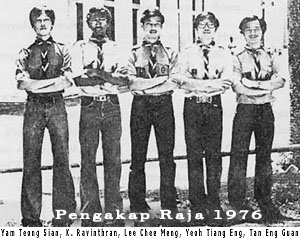 for the newly constructed Scout Den. Those six Scouts were from Second
KL, namely, Cheong Chai Thim, Lee Chee Meng, Ravinthran Krishnan, Tan
Eng Guan, Yam Teong Sian and Yeoh Tiang Eng. They were joined by another
member of Second KL, Yeoh Sock Siong, a year later. But 1977 was a year
dominated by the Pengakap Raja accolades of First KL, as they had four
new awardees in David Choong Chee Fong, Adrian Choong Teck Min, Lo Fook
Loong and Christopher Woo Chong Hin. A long hiatus followed this sudden
burst of Pengakap Raja in the mid 1970’s. Only in 1984, did the School
again see Pengakap Raja when two Scouts from First KL were standardised.
In November of that year, Ahmad Faudzi b. Abdul Razak and Azhar b. Ahmad
received their certificates for the award.
for the newly constructed Scout Den. Those six Scouts were from Second
KL, namely, Cheong Chai Thim, Lee Chee Meng, Ravinthran Krishnan, Tan
Eng Guan, Yam Teong Sian and Yeoh Tiang Eng. They were joined by another
member of Second KL, Yeoh Sock Siong, a year later. But 1977 was a year
dominated by the Pengakap Raja accolades of First KL, as they had four
new awardees in David Choong Chee Fong, Adrian Choong Teck Min, Lo Fook
Loong and Christopher Woo Chong Hin. A long hiatus followed this sudden
burst of Pengakap Raja in the mid 1970’s. Only in 1984, did the School
again see Pengakap Raja when two Scouts from First KL were standardised.
In November of that year, Ahmad Faudzi b. Abdul Razak and Azhar b. Ahmad
received their certificates for the award.
Compared to the prodigious 1960’s, the subsequent period saw a poor harvest of the highest accolade in Malaysian Scouting. But far from being inert in badgework, the Scouts did invest much time and effort into gaining Scouting skills through tests and badges. For instance, in 1974, Second KL had 16 Seniors with First Class badges and eight with Bushman’s Thongs. In 1975, there were several First Class holders in First KL and two Bushman’s Thongs in Second KL. There were also many, who, over the years, acquired badges like Camp Warden, Master Cook, Venturer Fireman, Lifesaver, Despatch Rider and Ambulance. And even when the Scout Reports in the Victorian magazines failed to report on badgework progress from the 1980’s onwards, this omission cannot be construed as an abandonment of badgework.
However, one comment can be made, particularly in regards to
Second KL badgework. In the mid 1980’s, Second KL perceived inadequacies and
lack of rigour in the newly revised test standards of the Persekutuan. The
Group thus faced a dilemma - choose between adhering to official and recognised
standards how ever diluted the requirements were, or pursue their own
course of badgework with more demanding requirements. The scales tipped
in favour of rigorous training and character building over sheer
credentialism and so Second KL maintained the old test standards that
had seen so many highly capable Scouts graduate from its ranks. As well,
the Group developed some tests of its own, but primarily the syllabus
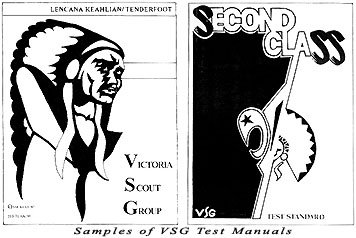 was a continuation of older syllabi. In short, the Second KL tests
comprised the new requirements of the Persekutuan, plus additional
requirements. Thus, for instance, the Second KL Tenderfoot test comprises
twelve tests while the Persekutuan Lencana Keahlian only has six. So Second
KL Scouts were certainly well-equipped to undertake any Scouting challenge.
was a continuation of older syllabi. In short, the Second KL tests
comprised the new requirements of the Persekutuan, plus additional
requirements. Thus, for instance, the Second KL Tenderfoot test comprises
twelve tests while the Persekutuan Lencana Keahlian only has six. So Second
KL Scouts were certainly well-equipped to undertake any Scouting challenge.
Over the years, the V.I. Scouts also attended training courses with external bodies to improve general knowledge and Scoutcraft. For instance, in 1981, a few First KL Seniors attended a Public Defence course organised by the Persekutuan. There, the Scouts were instructed in fire control and prevention, first aid, lifesaving, drills and other skills. The V.I. Scouts also developed a close rapport with the Jalan Hang Tuah/ Shaw Road Fire Station. On various occasions, the Fire Station conducted training courses for the V.I. Scouts, such as which occurred in 1977 when the First and Second KL Seniors attended a training course for the Fireman’s badge there, a relationship which stretched back many years. In fact, the tradition of fine ‘Fireman-ship’ dates back to the 1920’s, when under Mr Towle, the V.I. Scouts were trained to have some of the finest fire-fighting skills in the region. There were other training courses organised by the Persekutuan, at different places such as Kem Kota Raya (known as Castle Camp until 1977) and Kem Pelandok. The main point here is that the V.I. Scouts received support from external bodies in terms of training.
Yet, why did the V.I. Scouts have so few Pengakap Raja during
this epoch, if the high standards and the facilities for the Scouts were still
present? There are many possible answers. One answer is provided by the Scouts
from the 1980’s, who assert that their philosophy was that attaining the badge
itself is not the measure of Scouting standards. Rather, it is the skills
that one gains during his Scouting life that ought to be evaluated. This
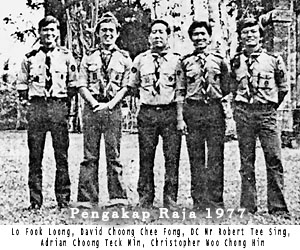 philosophy drove the V.I. Scouts to place less emphasis on the Pengakap Raja
award, though this is not to say that the Scouts did not desire it. Another
answer is that Scouting activities of the V.I. Scout Groups were not simply
oriented around badgework activities (unlike Troops from other schools), but
were more expansive. In order to attain a high level of badge achievements,
one would have had to sacrifice much time and effort in addition to the
ordinary Troop and Patrol activities. This was particularly true for Second
KL - given its self-developed test manuals, aspiring Pengakap Rajas would
have had to undertake tests under both the Group syllabus and the Persekutuan
syllabus. Other reasons for the lack of Pengakap Raja, particularly coming
from the critics, include the lack of time and resource management as well
as general apathy. However, such claims would have to be viewed against the
available evidence, which includes the winning of many a Scouting competition,
and the organising of numerous activities, camps and outings.
philosophy drove the V.I. Scouts to place less emphasis on the Pengakap Raja
award, though this is not to say that the Scouts did not desire it. Another
answer is that Scouting activities of the V.I. Scout Groups were not simply
oriented around badgework activities (unlike Troops from other schools), but
were more expansive. In order to attain a high level of badge achievements,
one would have had to sacrifice much time and effort in addition to the
ordinary Troop and Patrol activities. This was particularly true for Second
KL - given its self-developed test manuals, aspiring Pengakap Rajas would
have had to undertake tests under both the Group syllabus and the Persekutuan
syllabus. Other reasons for the lack of Pengakap Raja, particularly coming
from the critics, include the lack of time and resource management as well
as general apathy. However, such claims would have to be viewed against the
available evidence, which includes the winning of many a Scouting competition,
and the organising of numerous activities, camps and outings.
A WEEK IN THE LIFE OF A V.I. SCOUT

Scouting life inevitably revolves around the Scout Den. After many years of ‘temporary shelter’ - first in the furthest classroom on the upper level of the wing nearest the swimming pool, then in the former Cadet’s Armoury on the corner of the main building near the gate, and then the Jaga’s Hut opposite the V.I.O.B.A. - a new Scout Den was finally completed in on 31 January 1976, at the cost of $10, 943. The dream of many generations of V.I. Scouts to have a permanent Scout Den had finally been realised. The Den was to house much of the Troops’ belongings, and became a favourite hangout for the Scouts, even outside Troop meetings. (See Abode of the V.I. Scouts.)
Troop meetings were held on Saturdays for both Groups.
There were also meetings on weekdays to discuss preparations for the upcoming
Saturday meeting. First KL had theirs on Wednesdays while Second KL
had theirs on Thursdays. Meetings were short to inform the Troop about
the upcoming weekend meeting, after which, patrol meetings followed to
allocate duties for the Saturday meeting. There could also be some
physical training after that. Nonetheless, Saturday meetings were the
most important. Fall in was at 8.30 a.m. followed by attendance-taking,
mufti-inspection, the day’s agenda and a one hour swimming session for
each Group. After that could be a short drills, singing or badgework
session conducted by the Seniors, Scouters or Ex-Scouts. Meetings ended
around noon. Besides these meetings, there were also patrol duty days,
when the members of the rostered patrol would have to turn up after
school (or stay back after Saturday meetings) to tidy their Group’s side
of the Scout Den. There were additional meetings in the form of the Court
of Honour meetings if one held the position of PL, SPL or Scouter. For the
Scouts undertaking badgework, it would be on their own time either after
school or after a Saturday meeting, or even on a Sunday, such as the test
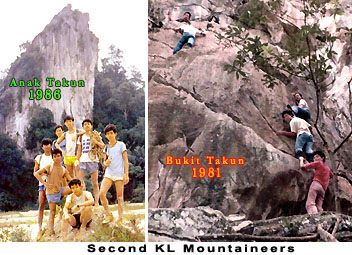 for Journey. The PL, Senior, Scouter or Ex-Scout with the necessary
credentials would be available for the test-taking. To equip the Scouts
with skills, sometimes a qualified Scout leader or Ex-Scout would organise
training courses outside Troop meeting times. Attendance could be optional,
but it would have been foolish to miss any course where words of wisdom
and experience were passed on.
for Journey. The PL, Senior, Scouter or Ex-Scout with the necessary
credentials would be available for the test-taking. To equip the Scouts
with skills, sometimes a qualified Scout leader or Ex-Scout would organise
training courses outside Troop meeting times. Attendance could be optional,
but it would have been foolish to miss any course where words of wisdom
and experience were passed on.
What activities did the COH plan for Saturday Troop meetings? Variety was their guiding philosophy in setting the agenda. These included games like Scoutball, wide games, base games, scavenger hunts, shows on Scouting, Mini Olympics, cooking competitions, pioneering, first aid sessions, talentimes, woodcraft and other Scoutcraft activities, drills, quizzes and obstacle courses/ commando training. Sometimes there would be events which capitalised on the latest fad around, such as in 1974 when the Second KL Boy Scouts had a roller-skating competition. There was even a bicycle-maintenance competition in 1976 for the First KL Boy Scouts, a wau-flying competition in 1977 for the Second KL Boy Scouts, and in 1986, the Second KL Scouts built a tree house (later emulated by First KL) and had a fishing competition. Community service days abounded too, such as Job Weeks, and outings, which are detailed in a later section. The Seniors of course had a larger range of choices, such as climbing Bukit Takun, Anak Takun or Loke Yew Hill (where the Scouts would often spend the night without the shelter of a canvas tent).
There were also games with the other uniformed groups in the
School such as the Second KL-V.I.C.C. Band games in 1979 and 1980. External
competitions were also not ignored, such as in 1978 when the First KL Seniors
took part in a canoe race at the Lake Gardens in conjunction with Federal Territory
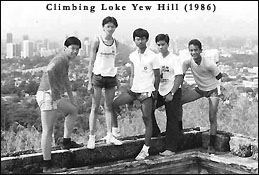 Day on 1 February. In 1985, Second KL Seniors competed in The Malay Mail
Big Walk in May, and most of them qualified for a merit certificate. Indeed,
the V.I. Scouts were never insular in their approach to Scouting. This epoch
saw the rise of joint meetings and gatherings, particularly with Girl Guide
Companies and Ranger Units. Such Companies and Units came from schools
including Ampang Girls’ School (with whom First KL Seniors went caving in
Anak Takun in 1977), Methodist Girls’ School (with whom First KL Seniors
went to Sungai Tua in 1978 and went caving in Anak Takun in 1980), Assunta
Girls’ School and St Mary’s Girls’ School. In terms of organising gatherings,
First KL occasionally held ‘An Evening With First KL’ where other Troops,
Units and Companies were invited for an evening of camaraderie such as which
took place in 1980 and 1983. The V.I. Scouts were also invited to many
gatherings and campfires of other schools each year, and sometimes even helped
those other schools to organise their events. For instance, it is noted that
the First KL Seniors helped the Methodist Girls’ School Girl Guides with their
campfire in 1978.
Day on 1 February. In 1985, Second KL Seniors competed in The Malay Mail
Big Walk in May, and most of them qualified for a merit certificate. Indeed,
the V.I. Scouts were never insular in their approach to Scouting. This epoch
saw the rise of joint meetings and gatherings, particularly with Girl Guide
Companies and Ranger Units. Such Companies and Units came from schools
including Ampang Girls’ School (with whom First KL Seniors went caving in
Anak Takun in 1977), Methodist Girls’ School (with whom First KL Seniors
went to Sungai Tua in 1978 and went caving in Anak Takun in 1980), Assunta
Girls’ School and St Mary’s Girls’ School. In terms of organising gatherings,
First KL occasionally held ‘An Evening With First KL’ where other Troops,
Units and Companies were invited for an evening of camaraderie such as which
took place in 1980 and 1983. The V.I. Scouts were also invited to many
gatherings and campfires of other schools each year, and sometimes even helped
those other schools to organise their events. For instance, it is noted that
the First KL Seniors helped the Methodist Girls’ School Girl Guides with their
campfire in 1978.
Quite contrary to the belief that ‘the twain were never to meet’, First and Second KL did cooperate on various occasions in organising activities. There were inter-Troop games between the two Groups, such as in 1974, 1976, 1978, 1981 and 1982. In fact, in 1981, First KL and Second KL formed a combined team in a sports tournament against the School Band and the rugby squad. Games included rugby, football, water polo, volleyball, basketball and tug-of-war. Besides games, the Groups also sometimes combined in setting up displays for the School Exhibitions which were held concurrently with V.I. Speech Day, as will be detailed later. And of course, when the First and Second KL Scouts were chosen to represent the District in inter-District competitions, like in the the 1985 State Competition Camp. Such was another example where the First and Second KL Scouts came together, though normally they treated each other as rivals.
It was not all smooth sailing for Troop activities. When the School organised replacement classes on Saturdays, Scout meetings could not be carried out. There was also usually an ebb in activities during the third term of each year owing to the major exams that were to take place. As well, the third term was usually a period when the newly appointed leaders, and the Seniors who had just ‘gone up’ to the Senior Troop were familiarising themselves with running the Troop. Nonetheless, these difficulties never impeded the Scouts from their activities.
TRADITIONS IN THE SCOUTING CALENDAR
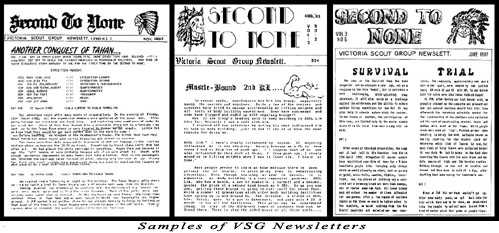
While diverse, the Scouting calendar contained certain activities which repeatedly featured in each year’s Scouting calendar. And in between hectic organisation and participation in these activities, time and effort was also spent on publishing Group newsletters and magazines. First KL occasionally published the ‘King Scout’ magazine, issued during their campfires or their gatherings. It contained news about the Group and articles on Scouting, among other things. This magazine was not regularly produced. Second KL was more prodigious in its publication efforts. Their tradition dates back to 1953, when the first Group newsletter, entitled Second KL Gazette was published termly. Unfortunately this undertaking lapsed, and was only revived in 1971, in the form of the Second To None newsletter. It lapsed again after 1980, but was rejuvenated in 1985 and was issued termly. Taking advantage of latest computer technology, the Editorial Board formatted the newsletter on half F4-sized pages, used a variety of fonts and liberally illustrated the newsletter with graphics - excellent training for journalism, publishing and artwork.
There were a few major ceremonies whose status in the Scouting calendar was almost sacred. The main ones were the Going-Up Ceremony or Installation, as well as the Investiture. The year would begin with a Going-Up/ Coming-Up Ceremony, which was tantamount to an Installation ceremony. It marked the ‘going up’ of Boy Scouts into the Senior Troop. The fifth and sixth formers were thus relieved of their duties and could concentrate on their upcoming exams. Held during the third term, or sometimes in the first term, this was then to be followed by the orientation programme. The Ceremony also involved the installation of the new leaders, a process which involved traditional rites of salutes and oath-taking. During the Ceremony too, the Scouts would be divided into their new patrols, with which they were to remain for the rest of the Scouting year. The next important Ceremony was the Investiture. Again an event replete with pomp and circumstance, Scouts would be pinned with the badges that they had earned during the previous months. For Tenderfoots, they receive their scarves (and if done according to strict tradition, their staffs and Scout hats too) which acknowledge their official induction into the brotherhood of Scouting.
There were several major camps. The Get-To-Know-You Camp
was a two-night camp where ‘freshies’ were introduced to camp life. These
were almost invariably held sometime in the first term every year for each
Troop. After (not necessarily immediately) the Get-To-Know-You Camps,
Competition Camps, the most grilling event of the Scouting calendar, would
be held. A four-night camp, it tested mental prowess, physical endurance
and Scout skills like cooking, gadget-construction. There were games like
scavenger and treasure hunts, Scoutcraft competitions like first aid, making
musical instruments, setting animal traps and entertainment. The Training
Camp was the parallel of the Competition Camp, but in a non-competitive
setting, which allowed Scouts to test ideas and Scouters to assess potential
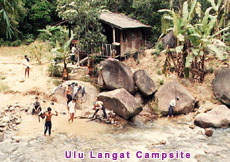 leaders. These were held either in the beginning of the year or in the second
half of the year. The campsites for these camps varied, including 15 1/2 mile
Gombak, John’s Valley, Castle Camp/ Kem Kota Raya, Kem Sardon Jubir in
Balakong (formerly Kem Semangat), Ulu Kanching (Kanching Pass) or Templer’s
Park, Pangsoon, Ulu Langat, Kuala Kubu Bharu and Lever’s Valley.
leaders. These were held either in the beginning of the year or in the second
half of the year. The campsites for these camps varied, including 15 1/2 mile
Gombak, John’s Valley, Castle Camp/ Kem Kota Raya, Kem Sardon Jubir in
Balakong (formerly Kem Semangat), Ulu Kanching (Kanching Pass) or Templer’s
Park, Pangsoon, Ulu Langat, Kuala Kubu Bharu and Lever’s Valley.
The Treasure Hunt was held over 12 to 17 hours, starting around 7 p.m. and ending the next morning. It took the Boy Scouts to different destinations around Kuala Lumpur (on foot!), searching for clues that were hidden by their Seniors and Scouters beforehand, which ultimately led them back to the school for the treasure. The overall winner was not simply the fastest patrol to discover the treasure but was determined by cumulative points (for patrol spirit, methods of clue-solving etc). During the night, the Seniors and Scouts functioned as ‘shadows’ on bicycles, assigned to supervise specific patrols and thus co-ordinate the movement of the Boy Scouts around the city. There were also Senior Treasure Hunts – these being similar to that Boy Scout Hunts, but with more challenge. For instance, the 1974 Second KL Senior Hunt took them on a 22-mile radius cycling experience, and, in May 1975, their Hunt covered a distance of about 50 miles and extended as far as Subang. The 1984 Senior Hunt for Second KL involved cycling to Subang International Airport, Zoo Negara in Ulu Klang and Salak South. First KL too had their share of arduous Hunts. Their 1977 Hunt covered a distance of over 50 miles. Unfortunately, the last Senior Hunt for Second KL took place in 1985, while First KL had had their last Senior Hunt before then. Since then, the Annual Hunts for both Groups had merely been for the Boy Scouts, with the Seniors serving as shadows. In addition, First KL also started the tradition of Night Games around 1983.
The results of all competitions and activities were totalled to determine the best patrol for the year, the highest Troop honour that a Boy Scout or Senior Scout patrol could aim for. Each major activity also had a trophy for the overall winner. Awards were given to the winner of the Treasure Hunt, Competition Camp and the Get-To-Know-You Camp. During the Annual Parents’ Campfires of each Group, there were also trophies for the best performances. The Second KL trophy for the best Campfire performance was called the Chan Lee Mun trophy, named in honour of the donor who was the Group’s ASM in 1971. First KL had Campfire trophies for the best overall performance and the best Boy Scout sketch; the former was the Plate trophy and the latter was the Jug trophy. In fact, First KL had names for almost all their trophies. The Dagger trophy was for the best patrol during the Competition Camp, the Drake trophy (Treasure Hunt) and for the best patrols of the year, there were the Mug trophy (for the Seniors) and the BP Trophy (for the Boy Scouts).
STRUTTING THEIR TALENT - ENTERTAINMENT AND SCOUTCRAFT

The Scouts always relished the opportunity to showcase their talents, and for this reason, the campfire was another grand event. Unlike the campfires of other schools, the campfires of the V.I. Troops are called the Annual Parents’ Campfire, because of the emphasis on parents during the event. It is a night when the achievements of the Troop are exhibited and performances involve almost every member. Performances vary each year; over the years there have been Rescue Acts, countless skitzes, bands, choirs, slide shows. The campfires have been a testimony to the immense talents of the Scouts. (See A History of the Second KL Parents' Campfire).
The Eleventh Annual Parents’ Campfire of First KL was staged
on 25 May 1974 at Castle Camp. On the occasion of the event, the Group published
the King Scout, which was their campfire magazine, and also compiled
their own song books. Second KL also held their Campfire in the second term
of that year. As in previous years, awards such as for the best performance
and best log book were presented on the night. The following year, 1975,
First KL their Campfire away from Castle Camp, in the V.I. compound, for
the first time, following a trend that had been started by Second KL. That
year, Second KL had their Annual Campfire for the sixth consecutive year on
21 June. Singing sessions were
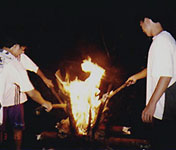 stepped up to alternate weeks, in the period leading up to the event, and
the logistical preparations were duly and carefully carried out. Other
Second KL Parents’ Campfires were held in 1977, 1978, 1979, 1980, 1982,
1984, 1985 and 1987; usually held around the second term (the School
calendar had three terms until 1989). First KL Campfires, besides those
in 1974 and 1975, have been recorded in 1976, 1977, 1979, 1982, 1984 and
1987. As this was an event attended by parents as well as other Scouts,
Girl Guides and Rangers, the V.I. Scouts gave their best efforts to
make Campfires memorable, particularly for the parents. During the 14th
First KL Annual Parents’ Campfire which was held in 1977, the Group
published a campfire magazine in conjunction with the event, just as
they published the King Scout for the 1974 Campfire. Part of the
stepped up to alternate weeks, in the period leading up to the event, and
the logistical preparations were duly and carefully carried out. Other
Second KL Parents’ Campfires were held in 1977, 1978, 1979, 1980, 1982,
1984, 1985 and 1987; usually held around the second term (the School
calendar had three terms until 1989). First KL Campfires, besides those
in 1974 and 1975, have been recorded in 1976, 1977, 1979, 1982, 1984 and
1987. As this was an event attended by parents as well as other Scouts,
Girl Guides and Rangers, the V.I. Scouts gave their best efforts to
make Campfires memorable, particularly for the parents. During the 14th
First KL Annual Parents’ Campfire which was held in 1977, the Group
published a campfire magazine in conjunction with the event, just as
they published the King Scout for the 1974 Campfire. Part of the
 funds - $600 - raised from the sale of the magazine were donated to
Asrama Cahaya. The 1979 Campfires were designed to be particularly
memorable due to the importance of that year. First KL celebrated the 70th
Anniversary of the founding of the V.I. Scout movement (however, as
analysed elsewhere, the belief that V.I. Scouts were founded in 1909 has
a long but misguided history). Second KL also celebrated the anniversary
of their 10th Annual Parents’ Campfire during the same term that year. In
order to impress the audience, and also to buoy the parents with the sons’
abilities, the V.I. Scouts set up gadget sites during their Campfires. The
1984 Campfire of First KL was held on the School Quadrangle on 3 November,
and Encik Abdul Aziz (the then DC of Sungei Besi, and later to become
Assistant State Commissioner for KL) was the guest of honour. Around 100
Scouts, Girl Guides and Rangers from 21 schools attended the event. In
conjunction with that event, they put up a display of a raised bed, Scout
weapons and a monkey bridge. Second KL also constructed gadgets such as
elaborately weaved archways and other pioneering projects during its
Campfires.
funds - $600 - raised from the sale of the magazine were donated to
Asrama Cahaya. The 1979 Campfires were designed to be particularly
memorable due to the importance of that year. First KL celebrated the 70th
Anniversary of the founding of the V.I. Scout movement (however, as
analysed elsewhere, the belief that V.I. Scouts were founded in 1909 has
a long but misguided history). Second KL also celebrated the anniversary
of their 10th Annual Parents’ Campfire during the same term that year. In
order to impress the audience, and also to buoy the parents with the sons’
abilities, the V.I. Scouts set up gadget sites during their Campfires. The
1984 Campfire of First KL was held on the School Quadrangle on 3 November,
and Encik Abdul Aziz (the then DC of Sungei Besi, and later to become
Assistant State Commissioner for KL) was the guest of honour. Around 100
Scouts, Girl Guides and Rangers from 21 schools attended the event. In
conjunction with that event, they put up a display of a raised bed, Scout
weapons and a monkey bridge. Second KL also constructed gadgets such as
elaborately weaved archways and other pioneering projects during its
Campfires.
Besides during Campfires, the Scouts flaunted their entertainment skills on many other occasions. The V.I. Founder’s Day was a popular event for the Scouts to strut their talent, such as which occurred in 1974 and 1975. The School Concert was yet another such event. For instance, in 1975, First KL enacted a western comedy entitled High Noon during the School Concert, for which they were widely commended. Perhaps the major event, besides the Campfires, where the entertainment and organisation abilities of the Scouts were put to the test, was the Gang Show. In the second term of 1976, First KL put up a Gang Show, and in seeking to continue the theme of their last Gang Show in 1973 (with the theme What’s Up, Scouts?), they titled this Show What’s Up, Scouts? - II. Mr Johnny Yap, a former Scout of the Group played a major role in helping to organise the event. The Gang Show included a fashion show by professional models under the choreography of forer Miss Malaysia Miss Maggie Loo, dances and singing. Funds raised were used for buying equipment for the new Scout Den. Meanwhile, there were other arenas used by the Scouts for showing off their performance talents; public arenas being one of them. In 1978 Second KL put up a drama entitled Jali-jali at the Shaw Road Community Hall on 4 February on the occasion of the Federal Territory Day and later staged the same play at Panggung Anniversary in conjunction with Founder’s Day on 22 February.
School Exhibitions, which were grand annual displays of the V.I. Boys’ talents, craftmanship and ideas, also saw the heavy involvement of the Scouts. In 1975, the first Exhibition after a three year hiatus, First KL carried off the award for the best overall exhibition. Second KL also received a special commendation award for their 'Victoria Scout Complex'. It featured among other attrations, a Parabolic Hyperboloid gateway, an Aerial Runway which was a hit particularly among girls, a split-level raised platform displaying exhibits and a water fountain enclosed by a horse-shoe table. Their complex also contained a campfire circle, a P.H. flagpole and a multi-coloured stone-bed displaying the Scout emblem and establishment of the Group. In 1976, 1977 and 1978, the Scout Exhibitions, each held over two days, were collaborations between First and Second KL. The 1976 affair was a particularly joyous one as it was held in conjunction with the newly officiated V.I. Scout Den. There was no mention of an Exhibition in 1979. It was around this time that the V.I. Exhibition ceased to exist as an annual affair, and thus the Scouting Exhibitions were also relegated to the annals of history. Nonetheless, the Scouts still put up the occasional display when called for. For instance, in 1979, Second KL put up a fire emergency and life saving display during the Annual Speech Day of the School. Later, during the V.I. Fun Fair organised by the Persatuan Ibubapa Dan Guru-guru (Parent Teacher Association) in 1982, First KL put up an exhibition on the Scouting activities of the Group. On that occasion, Second KL set up a sophisticated gadget site which included two towers, a tree house, a Monkey Bridge and an Aerial Runway, besides giving demonstrations of Scoutcraft which fascinated their audience.
OUTINGS, TRIPS AND EXPEDITIONS
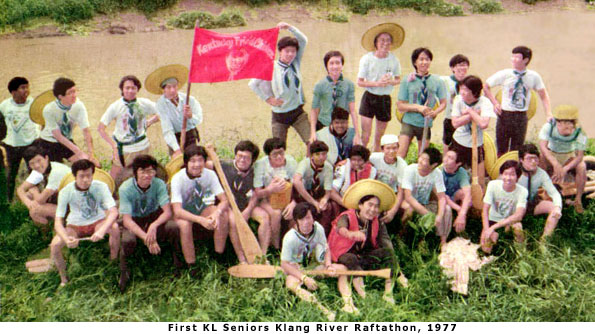
Many people cite, as one of their major reasons for being interested in the Scouting movement, the opportunity to frolic outdoors. Whether it be a trip to a nearby forest such as Ulu Kanching for a splash in the river and waterfall, or whether it be a journey further afield such as to Port Dickson or Singapore, Scouts relished outings. Sleeping under the stars was certainly very appealing. Activities like these served to inspire and refresh the Scouts from routine Scouting activities. Thus, outings and expeditions were an integral part of the Scouting calendar.
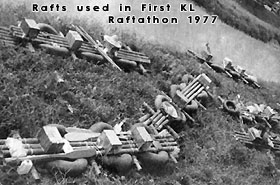 The money raised was used for three purposes. Firstly, it went towards
financing the equipment for the expedition, such as the rafts. Then,
donations were made to the Kampuchean Refugee Fund. The remainder of the
money was used for purchasing new Scout equipment such as ponchos and
parangs.
The money raised was used for three purposes. Firstly, it went towards
financing the equipment for the expedition, such as the rafts. Then,
donations were made to the Kampuchean Refugee Fund. The remainder of the
money was used for purchasing new Scout equipment such as ponchos and
parangs.
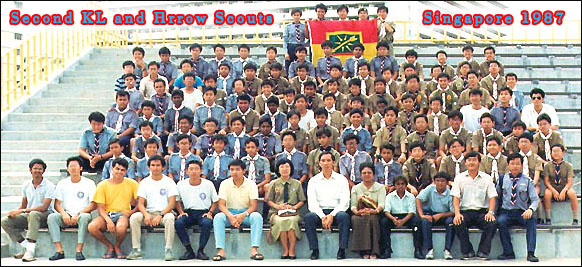
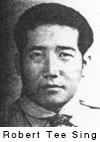
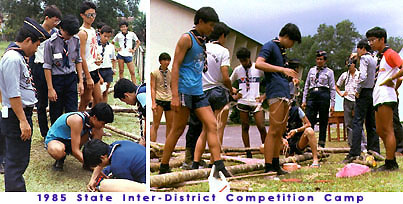 fact, crowning the 1978 Group victory was the individual achievement
of Ho Yuen Seng (then a Boy Scout but who would later become ASM of
Second KL in 1981) when he was selected as the best Scout in
Selangor and Kuala Lumpur. Likewise, for the Second KL Seniors to
emerge fourth in a national competition such as in 1981 was
definitely no mean feat. They had to first succeed in the District
and State competitions, only after which the Seniors gained the
honour to represent the state at the National Scoutcraft Tournament
which was held at the Sekolah Tinggi Kluang, Johor, from 17 to 22
December 1981. Seven Seniors represented Second KL, and their
achievement effectively made them the official fourth best Group in
the nation. First KL also had many achievements as noted above. For
instance, in the 1985 State Inter-District Competition Camp held at
SRK Sri Delima, Jalan Ipoh in March in conjunction with Founder’s Day,
First KL had seven representatives in the District Contingent. In fact,
the contingent was predominantly made up of V.I. Scouts, with Second
KL having 14 representatives in that contingent... and the contingent
eventually emerged as champions!
fact, crowning the 1978 Group victory was the individual achievement
of Ho Yuen Seng (then a Boy Scout but who would later become ASM of
Second KL in 1981) when he was selected as the best Scout in
Selangor and Kuala Lumpur. Likewise, for the Second KL Seniors to
emerge fourth in a national competition such as in 1981 was
definitely no mean feat. They had to first succeed in the District
and State competitions, only after which the Seniors gained the
honour to represent the state at the National Scoutcraft Tournament
which was held at the Sekolah Tinggi Kluang, Johor, from 17 to 22
December 1981. Seven Seniors represented Second KL, and their
achievement effectively made them the official fourth best Group in
the nation. First KL also had many achievements as noted above. For
instance, in the 1985 State Inter-District Competition Camp held at
SRK Sri Delima, Jalan Ipoh in March in conjunction with Founder’s Day,
First KL had seven representatives in the District Contingent. In fact,
the contingent was predominantly made up of V.I. Scouts, with Second
KL having 14 representatives in that contingent... and the contingent
eventually emerged as champions!
